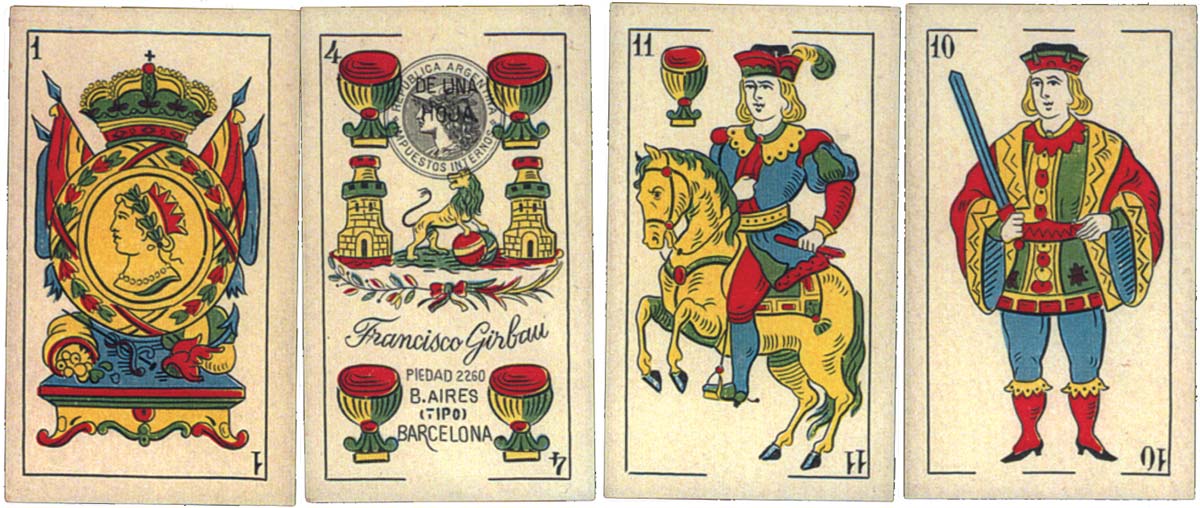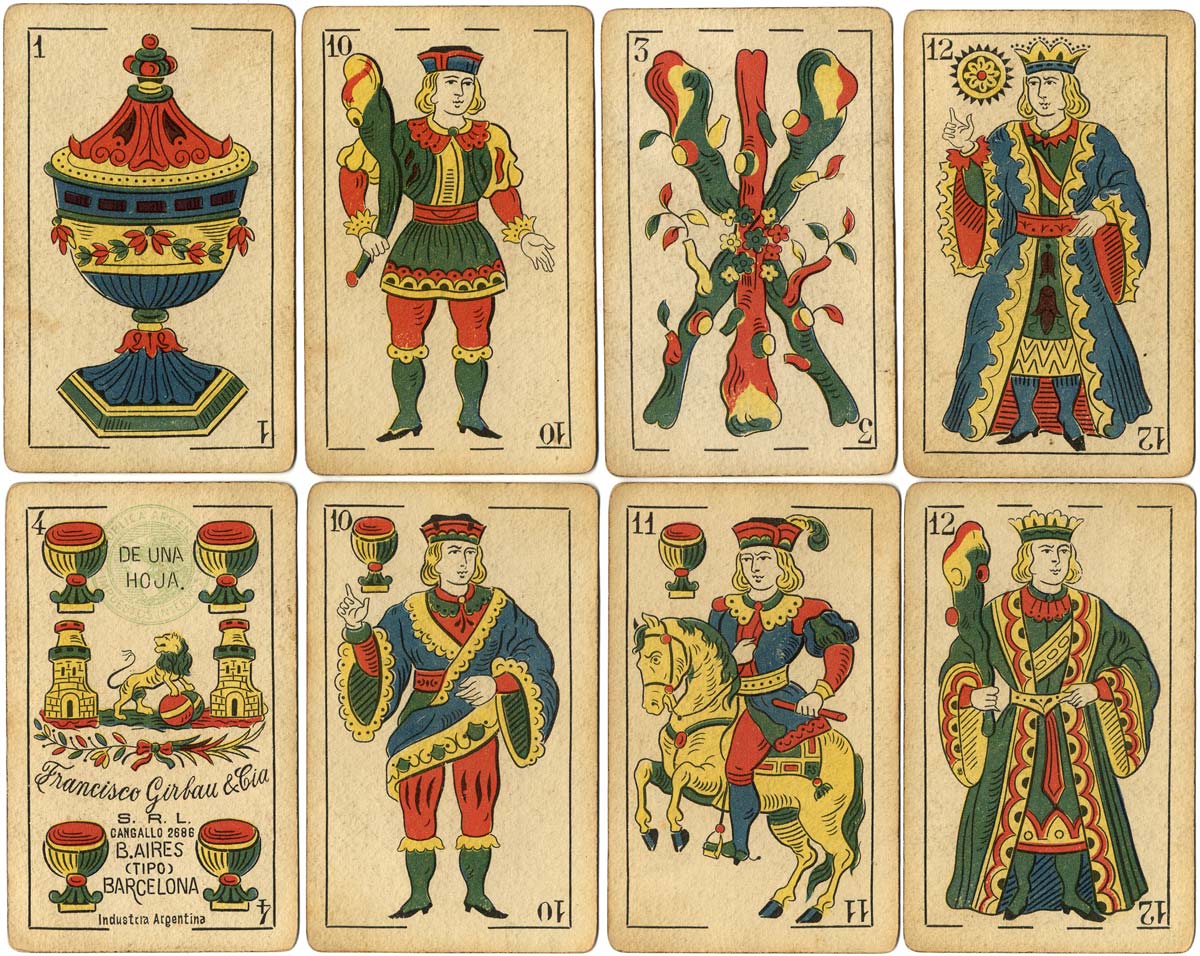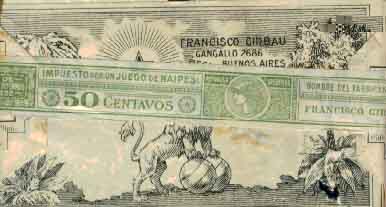Francisco Girbau & Cia, Buenos Aires
Francisco Girbau & Cia, Buenos Aires, c.1890-1935

Francisco Girbau & Cia, Buenos Aires, c.1890-1935
Piedad 2260, Bs.As.
Also: Cangallo 2686, Bs.As.
The firm was originally founded by Francisco Girbau in Igualada (Barcelona) in c.1830. After being handed down from father to son it became Francisco Girbau & Cia. The business was relocated to Buenos Aires in 1890 and operated from the addresses shown above, which can also be found on the fours of cups.

Above: four cards from a 40-card pack made by Francisco Girbau, early 1900s, printed by colour lithography and with square corners. The black 'Mercury' tax stamp on the four of cups was used during the period 1895-1905 (approx.). The address is given on the four of cups as Piedad 2260. The inscription "Tipo Barcelona" on the four of cups refers to the Spanish Catalan pattern which is associated with Barcelona and which became popular in several South American countries. The same designs were subsequently used by Fourvel and Cappellano.

Above: four cards from a slightly later 40-card pack made by Francisco Girbau, c.1920, printed by colour lithography and with square corners. The green 'Mercury' tax stamp (first version) on the four of cups is from the period c.1905-1920. The address is now given on the four of cups as Cangallo 2686, B. Aires. The back design can be either crossed lines or a single colour applied by brush►

Above: four cards from a 40-card pack made by Francisco Girbau & Cía, S.R.L., c.1930s, printed by colour lithography and with rounded corners. The green 'Mercury' tax stamp (second version) on the four of cups is from the period c.1920-1945. The company name has changed to a limited company, and address given is Cangallo 2686, B. Aires. The legend 'Industria Argentina' also appears at the bottom of the four of cups.

Left: wrapper showing the 50 Centavos outer tax band, from a deck made by Francisco Girbau at his second address: Cangallo 2686, from c.1915-20. (Image courtesy of Jose Luiz G Pagliari.)
ACKNOWLEDGEMENTS
Thanks to Maria Marcet for information about her family ancestors.

By Simon Wintle
Member since February 01, 1996
I am the founder of The World of Playing Cards (est. 1996), a website dedicated to the history, artistry and cultural significance of playing cards and tarot. Over the years I have researched various areas of the subject, acquired and traded collections and contributed as a committee member of the IPCS and graphics editor of The Playing-Card journal. Having lived in Chile, England, Wales, and now Spain, these experiences have shaped my work and passion for playing cards. Amongst my achievements is producing a limited-edition replica of a 17th-century English pack using woodblocks and stencils—a labour of love. Today, the World of Playing Cards is a global collaborative project, with my son Adam serving as the technical driving force behind its development. His innovative efforts have helped shape the site into the thriving hub it is today. You are warmly invited to become a contributor and share your enthusiasm.
Related Articles

Visite Mexico
Promoting Mexican tourism with 54 different photographs in full colour.

Jockey Club de Buenos Aires
Spanish-suited pack by Chas Goodall & Son Ltd for the Jockey Club, Buenos Aires.

Catalan pattern by B.P Grimaud
Standard Spanish Catalan pattern deck made in Paris by B.P Grimaud.

Archaic Spanish proof sheets
2 x uncoloured proof sheets of archaic Spanish-suited playing cards produced for “New Spain”, possib...

Peintres Latino Americains
Original artwork by 18 different Latin American artists.

B.P. Grimaud pack for Bolivia
Spanish-suited pack made in France for sale in Bolivia, c.1880.

José Maria Durán
Spanish Catalan pattern by José Maria Durán, Barcelona, c.1870.

Pou y Cía
Catalan pattern made by Pou y Cía, Madrid c.1860.

South American Costumes
Costumes of people of Brazil, Peru and Mexico, with views of Rio de Janeiro on the aces.

Félix Solesio e Hijos
Félix Solesio e Hijos - Real Fábrica de Madrid - Spanish National pattern for Venezuela

Sanmartí Catalan pattern
Standard Catalan designs of the late 19th century by Sucesores de Viuda Sanmartí e Hijo, Barcelona. ...

Guarro y Cia Catalan pattern
Catalan pattern (‘Escudo de Barcelona’) with youthful courts and attractive colouring.

Alejo Gabarró Catalan pattern
Alejo Gabarró “El Cuervo” Catalan pattern playing cards, Igualada, Spain, c.1904.

Parisian Spanish pattern by Fossorier, Amar et Cie
‘Parisian’ Spanish pattern published by Fossorier, Amar et Cie (Paris), c.1902.

Félix Solesio e Hijos
Félix Solesio e Hijos, Fábrica de Macharaviaya, Spanish National pattern for West Indies, 1801.

Naipe de Bridge
Standard English pattern pack made in Ecuador, c.1970.
Most Popular
Our top articles from the past 28 days

